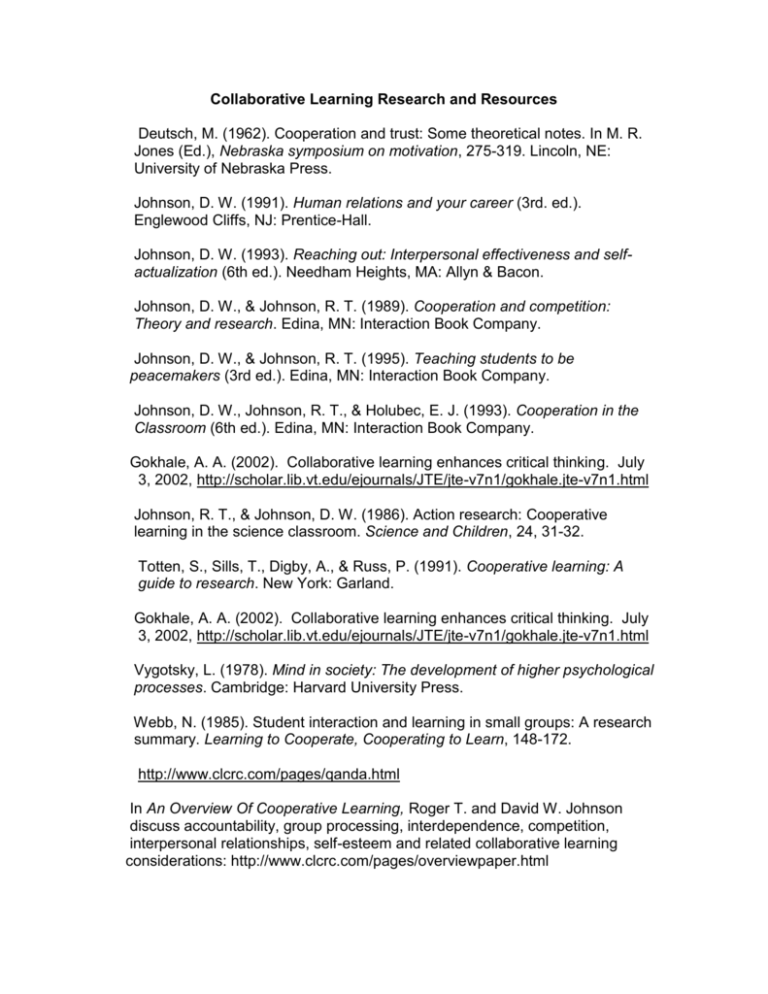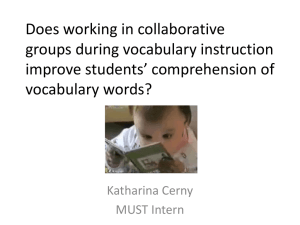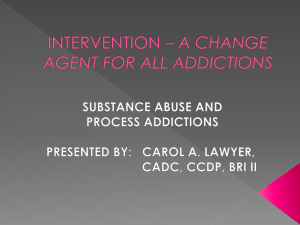Collaborative Learning Research and Resources
advertisement

Collaborative Learning Research and Resources Deutsch, M. (1962). Cooperation and trust: Some theoretical notes. In M. R. Jones (Ed.), Nebraska symposium on motivation, 275-319. Lincoln, NE: University of Nebraska Press. Johnson, D. W. (1991). Human relations and your career (3rd. ed.). Englewood Cliffs, NJ: Prentice-Hall. Johnson, D. W. (1993). Reaching out: Interpersonal effectiveness and selfactualization (6th ed.). Needham Heights, MA: Allyn & Bacon. Johnson, D. W., & Johnson, R. T. (1989). Cooperation and competition: Theory and research. Edina, MN: Interaction Book Company. Johnson, D. W., & Johnson, R. T. (1995). Teaching students to be peacemakers (3rd ed.). Edina, MN: Interaction Book Company. Johnson, D. W., Johnson, R. T., & Holubec, E. J. (1993). Cooperation in the Classroom (6th ed.). Edina, MN: Interaction Book Company. Gokhale, A. A. (2002). Collaborative learning enhances critical thinking. July 3, 2002, http://scholar.lib.vt.edu/ejournals/JTE/jte-v7n1/gokhale.jte-v7n1.html Johnson, R. T., & Johnson, D. W. (1986). Action research: Cooperative learning in the science classroom. Science and Children, 24, 31-32. Totten, S., Sills, T., Digby, A., & Russ, P. (1991). Cooperative learning: A guide to research. New York: Garland. Gokhale, A. A. (2002). Collaborative learning enhances critical thinking. July 3, 2002, http://scholar.lib.vt.edu/ejournals/JTE/jte-v7n1/gokhale.jte-v7n1.html Vygotsky, L. (1978). Mind in society: The development of higher psychological processes. Cambridge: Harvard University Press. Webb, N. (1985). Student interaction and learning in small groups: A research summary. Learning to Cooperate, Cooperating to Learn, 148-172. http://www.clcrc.com/pages/qanda.html In An Overview Of Cooperative Learning, Roger T. and David W. Johnson discuss accountability, group processing, interdependence, competition, interpersonal relationships, self-esteem and related collaborative learning considerations: http://www.clcrc.com/pages/overviewpaper.html In New Learning and Thinking Curricula Require Collaboration, Tinzmann, Fennimore, Jones, Bakker, and Pierce provide a thorough discussion of characteristics of a collaborative classroom, student and teacher roles, challenges and conflicts, and the research basis for collaborative learning. http://www.ncrel.org/sdrs/areas/rpl_esys/collab.htm Angelo, T. A. and Cross, K. P. (1993). Classroom assessment techniques: A handbook for college teachers, 2nd edition, San Francisco, Jossey-Bass. Goodsell, A. S., Maher, M. R., and Tinto, V., Eds., (1992). Collaborative learning: A sourcebook for higher education. National Center on Postsecondary Teaching, Learning, & Assessment, Syracuse University. http://www.id.ucsb.edu/IC/Resources/Collab-L/xxx.html) Rau, W. & Heyl, B. S. (1990). Humanizing the college classroom: Collaborative learning and social organization among students. Teching Sociology, 18, 141155. http://scholar.lib.vt.edu/ejournals/JTE/jte-v7n1/gokhale.jte-v7n1.html) http://www.temple.edu/LC/general-info.html Levine, J. H. (2002). Beyond a definition of learning communities. July 8, 2002, http://www.temple.edu/LC/general-info.html http://www.id.ucsb.edu/IC/Resources/Collab-L/xxx.html Gokehale: http://scholar.lib.vt.edu/ejournals/JTE/jte-v7n1/gokhale.jte-v7n1.html Rau, W. & Heyl, B. S. (1990). Humanizing the college classroom: Collaborative learning and social organization among students. Teaching Sociology, 18, 141155. In Key Points Concerning Group Assignments Bernard Erven and Carl Zulauf provide tips on how to form and manage groups. http://www.osu.edu/education/ftad/Publications/keypoints.html Beebee, A. B., Masterson, J. T. (2000). Communicating in small groups: principles and practices. Cross, K. P. (2000). Collaborative learning 101. Educational Testing Service. Cross, K. P. (2001). Motivation: Er…Will that be on the test? Educational Testing Service. Cross, K. P. (2002). The role of class discussion in the learning-centered classroom. Educational Testing Service. Engleberg, I. N., Wynn, D.R. (2000). Working in groups: Communication principles and strategies.







